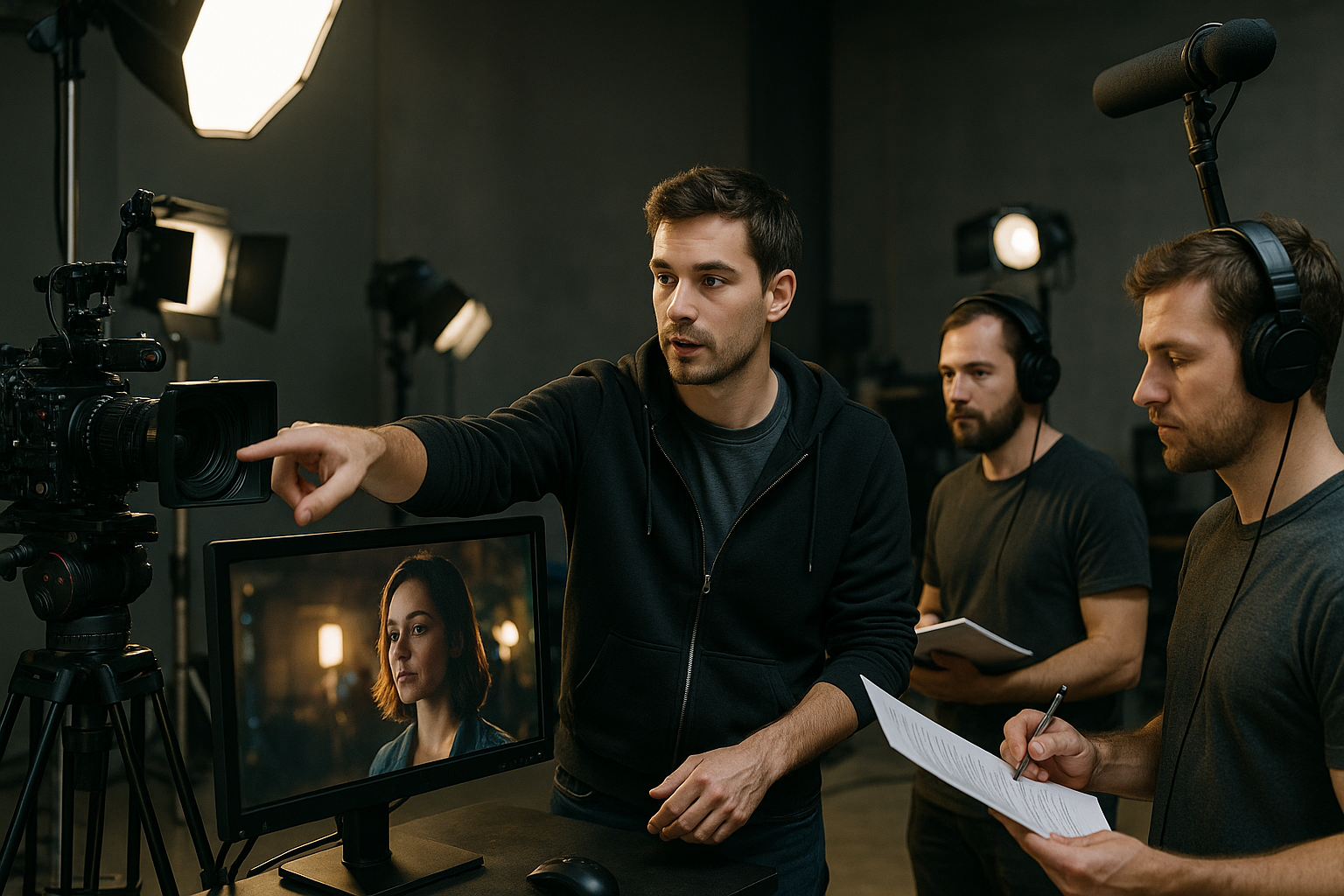In the ever-evolving realm of cinematography, the statement “work smarter, not harder” 🤔 is more than just a mantra. It’s a pragmatic approach to creating high-quality content that captivates audiences. Today, we delve into the intricate and fascinating world of smart filmmaking, where your cinematic potential is unlocked through smart and effective strategies for maximum impact. Prepare for an exhilarating journey through the best practices, techniques, and technologies that are set to revolutionize the filmmaking process. So grab your director’s chair, it’s lights, camera, action! 🎬
The crux of this article lies in understanding that filmmaking is no longer a domain for those with deep pockets and hefty resources. In our digital era, it’s about applying shrewd tactics and leveraging cutting-edge technology to produce compelling and high-impact content. The goal is simple: film smarter, not harder, and transform your cinematic vision into a reality. So, are you ready to upgrade your skills, and elevate your content? Let’s dive in!
Our voyage commences with a thorough exploration of the concept of smart filmmaking. What does it entail? How does it revolutionize traditional filmmaking techniques? We will dissect the intricacies of this new-age approach, providing an in-depth understanding of how to apply it in your productions. 🎥
Mastering The Art of Storytelling
Next, we shift our focus to the very heart of any film – the story. It’s not just about what you’re telling, but how you’re telling it. We’ll delve into the nuances of effective storytelling, discussing how to weave intricate narratives that resonate with your audience. From scriptwriting to shot composition, we’ll provide practical insights that can make your story more engaging and visually stunning.
Optimizing the Use of Technology
The role of technology in smart filmmaking cannot be overstated. From the latest camera equipment to editing software, we’ll explore how to make the most out of these tools to enhance your production value. We’ll dive into techniques that can dramatically improve your filming efficiency and quality without the need for extravagant budgets. 🖥️
Efficient Workflow and Time Management
Time is the most valuable asset on a film set. Effective time management and efficient workflows are key to maximizing your productivity without compromising on quality. We’ll cover strategies to streamline your processes, tips to manage your shooting schedule effectively, and ways to avoid common pitfalls that can slow down your production.
As we navigate through these exciting topics, we’ll offer practical advice, proven strategies, and insightful tips, all aimed at enabling you to film smarter, not harder. We’ll share the secrets of some of the most successful filmmakers, giving you the tools to improve your skills, boost your efficiency, and create content that truly stands out. 🌟
Whether you’re a seasoned professional looking to refine your approach, or an aspiring filmmaker eager to learn the ropes, this article is designed to help you unlock your full cinematic potential. Prepare for a rich tapestry of insights and ideas that can transform the way you approach your craft. So, sit back, relax, and enjoy the journey to smarter filmmaking. 🍿
Unlocking Your Cinematic Potential: A Deep Dive into Filming Smarter
It’s not about having the best equipment or the most expensive set, but about understanding the elements that make a film impactful. By learning how to use the tools you have effectively, you can unlock your cinematic potential and create compelling, high-quality films.
With the rise of video-sharing platforms like YouTube, the demand for high-quality, engaging content has never been greater. However, with the deluge of videos being uploaded every minute, standing out from the crowd can be quite a challenge. This is where the importance of filming smarter, not harder, comes into play.
Through this article, we will explore some key strategies to maximize your impact without necessarily increasing your workload. We will delve into the nuances of planning, filming, and post-production, providing you with a comprehensive guide on how to film smarter. Let’s dive in!
Planning: The Bedrock of Efficient Filmmaking
The foundation of any great film lies in its planning stage. A well-thought-out plan can save you from unforeseen troubles during filming and post-production. It helps you stay organized, maintain a clear vision, and manage your resources efficiently.
Storyboarding is a technique widely used in the industry to visualize the film scene by scene. It aids in understanding the flow of the story, determining the camera angles, and planning the shots. Not only does it save time on set, but it also helps you communicate your vision effectively with your crew.
Another crucial aspect of planning is location scouting. Familiarizing yourself with the location beforehand can help you plan your shots better and mitigate potential problems. It’s not just about finding a beautiful location but ensuring it suits your narrative, has good light conditions, and is logistically feasible.
Pro Tip: “The Five P’s – Proper Planning Prevents Poor Performance.”
Developing a shooting schedule can be a game-changer. It helps manage time effectively, keeping track of the scenes to be shot, the actors involved, and the equipment needed. Furthermore, it aids in budgeting, as knowing when and where you’re shooting can help estimate costs more accurately.
Techniques to Enhance Your Filming Process
Once you have a solid plan in place, it’s time to delve into the filming process. This is where your creative prowess comes to the fore, where you capture the heart of your story.
First and foremost, understanding your camera and its settings is crucial. You should be comfortable adjusting the aperture, shutter speed, and ISO, among other settings, to capture the best possible shot under varying conditions. You don’t need the most expensive equipment to create a great film; you just need to know how to use what you have effectively.
The rule of thirds, leading lines, and depth of field are some basic cinematography techniques that can significantly enhance your shots. The rule of thirds involves dividing the frame into a 3×3 grid and placing the important elements along those lines or at their intersections. Leading lines guide the viewer’s eye towards the main subject, while depth of field helps you highlight the subject by blurring the background.
Recommended Video: “Cinematography Techniques: The Different Types of Shots in Film” by Filmora Video Editor
Lighting plays a pivotal role in setting the mood of a scene. By manipulating light and shadows, you can evoke a range of emotions, from happiness and hope to fear and suspense.
Finally, don’t forget the importance of sound. Good audio quality can make or break your film. Invest in a good microphone, keep track of the ambient noise, and consider incorporating a background score to enhance the emotional impact of your scenes.
Post-Production: Perfecting Your Film
Post-production is where the magic happens. It’s where you piece together your story, refine your shots, and add the final touches that bring your film to life.
Editing is a powerful tool that can make or break your film. A well-edited film flows smoothly, maintaining the audience’s interest and driving the narrative forward. On the other hand, poor editing can make even the most beautifully shot film seem disjointed and confusing.
Color grading is another important aspect of post-production. It can greatly enhance the aesthetic appeal of your film, help set the mood, and even influence the audience’s emotions. Experimenting with different color grades can help you find the perfect look for your film.
Recommended Video: “Color Grading in Film: Beginner’s Guide” by Indy Mogul
Sound design, like color grading, can enhance the overall impact of your film. It involves adding sound effects, adjusting the audio levels, and incorporating music to enhance the narrative. A well-designed sound can significantly elevate the viewing experience, making your film more immersive and engaging.
Mastering the Art of Filmmaking: Key Takeaways
Unlocking your cinematic potential is not about investing in the most expensive equipment, but understanding the art and science of filmmaking. By planning meticulously, honing your filming techniques, and refining your post-production skills, you can create compelling films that leave a lasting impact on your audience.
It’s about adopting a smarter approach to filmmaking – being resourceful, staying organized, and constantly learning and improving. So, are you ready to unlock your cinematic potential and create films that resonate with your audience? Remember, the world is your stage, and the camera is your tool. Use it wisely to tell your story.
For more in-depth insights and practical tips, I highly recommend checking out the videos mentioned in this article. They offer invaluable knowledge that can help you elevate your filmmaking skills to new heights. Happy filming!

Conclusion
As we wrap up this detailed dive into the intricate world of Information Technology and Engineering, it’s essential to recap the key takeaways. In the spirit of maintaining our technical but accessible tone, I’ll condense these complex concepts into bite-sized, digestible nuggets of information.
The first point we examined was the rapid evolution of technology and its impact on society. The ubiquitous nature of technology has transformed our daily lives, from how we communicate and socialize to how we work and learn. This change is not without challenges, but as we’ve discovered, with the right skills and tools, we can harness the power of technology to our advantage. 💪
Next, we delved into the principles of software engineering. We covered the different development methodologies, including Waterfall, Agile, and DevOps, and how they shape the way software is designed, built, and delivered. Crucially, we also highlighted the importance of robust software testing practices, which ensure the quality and reliability of our digital products. 🛠️
We then explored the exciting realm of Artificial Intelligence (AI) and Machine Learning (ML), demystifying these often misunderstood concepts. AI and ML are not just buzzwords; they’re powerful tools that can automate tasks, enhance decision-making, and unlock unprecedented levels of efficiency and innovation. 👁️
Finally, we examined the ethical considerations of technology. As we develop increasingly advanced systems, it’s vital to consider the potential implications for privacy, security, and societal impact. This final point underscored the significance of our discussions, showing that the stakes are high, but so are the rewards. ⚖️
The journey we’ve undertaken in this article has been both enlightening and inspiring, and I hope it’s equipped you with the knowledge and insights to navigate the tech world with confidence. Remember, your learning doesn’t have to end here. There are plenty of online resources, such as [Coursera](https://www.coursera.org/browse/computer-science) and [Udemy](https://www.udemy.com/), where you can continue to expand your understanding.
As we continue to explore this fascinating field, I encourage you to engage with this content, share your thoughts, and apply what you’ve learned in your professional or personal life. If you have any questions or insights, don’t hesitate to leave a comment below. Sharing knowledge is one of the best ways to learn, after all. 🎓
Here’s to a future filled with technological progress, where we, as a society, are not just passive consumers, but active participants and innovators. To a future where technology empowers us, rather than overpowers us. Together, let’s continue to learn, grow, and build a better digital world. 🚀
[TechRadar](https://www.techradar.com/) and [TechCrunch](https://techcrunch.com/) are also excellent sources for staying updated on the latest developments in the tech industry.
So, stay curious, keep learning, and remember: the possibilities are endless. 🌠
References:
[1] Encyclopedia Britannica – Software Engineering
[2] IBM – Machine Learning
[3] Stanford Encyclopedia of Philosophy – Ethics of Artificial Intelligence and Robotics



